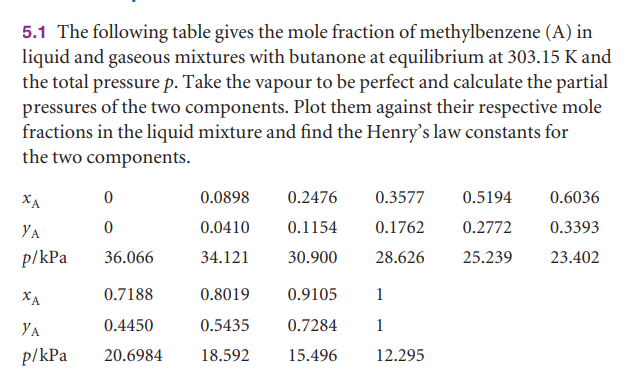5.1 The following table gives the mole fraction of methylbenzene (A) in liquid and gaseous mixtures with butanone at equilibrium at 303.15 K and the total pressure p. Take the vapour to be perfect and calculate the partial pressures of the two components. Plot them against their respective mole fractions in the liquid mixture and find the Henry's law constants for the two components. XA 0.0898 0.2476 0.3577 0.5194 0.6036 YA 0.0410 0.1154 0.1762 0.2772 0.3393 p/kPa 36.066 34.121 30.900 28.626 25.239 23.402 XA 0.7188 0.8019 0.9105 1 YA 0.4450 0.5435 0.7284 1 p/kPa 20.6984 18.592 15.496 12.295
5.1 The following table gives the mole fraction of methylbenzene (A) in liquid and gaseous mixtures with butanone at equilibrium at 303.15 K and the total pressure p. Take the vapour to be perfect and calculate the partial pressures of the two components. Plot them against their respective mole fractions in the liquid mixture and find the Henry's law constants for the two components. XA 0.0898 0.2476 0.3577 0.5194 0.6036 YA 0.0410 0.1154 0.1762 0.2772 0.3393 p/kPa 36.066 34.121 30.900 28.626 25.239 23.402 XA 0.7188 0.8019 0.9105 1 YA 0.4450 0.5435 0.7284 1 p/kPa 20.6984 18.592 15.496 12.295
Introduction to Chemical Engineering Thermodynamics
8th Edition
ISBN:9781259696527
Author:J.M. Smith Termodinamica en ingenieria quimica, Hendrick C Van Ness, Michael Abbott, Mark Swihart
Publisher:J.M. Smith Termodinamica en ingenieria quimica, Hendrick C Van Ness, Michael Abbott, Mark Swihart
Chapter1: Introduction
Section: Chapter Questions
Problem 1.1P
Related questions
Question

Transcribed Image Text:5.1 The following table gives the mole fraction of methylbenzene (A) in
liquid and gaseous mixtures with butanone at equilibrium at 303.15 K and
the total pressure p. Take the vapour to be perfect and calculate the partial
pressures of the two components. Plot them against their respective mole
fractions in the liquid mixture and find the Henry's law constants for
the two components.
XA
0.0898
0.2476
0.3577
0.5194
0.6036
YA
0.0410
0.1154
0.1762
0.2772
0.3393
p/kPa
36.066
34.121
30.900
28.626
25.239
23.402
XA
0.7188
0.8019
0.9105
1
YA
0.4450
0.5435
0.7284
1
p/kPa
20.6984
18.592
15.496
12.295
Expert Solution
This question has been solved!
Explore an expertly crafted, step-by-step solution for a thorough understanding of key concepts.
This is a popular solution!
Trending now
This is a popular solution!
Step by step
Solved in 2 steps with 4 images

Recommended textbooks for you

Introduction to Chemical Engineering Thermodynami…
Chemical Engineering
ISBN:
9781259696527
Author:
J.M. Smith Termodinamica en ingenieria quimica, Hendrick C Van Ness, Michael Abbott, Mark Swihart
Publisher:
McGraw-Hill Education

Elementary Principles of Chemical Processes, Bind…
Chemical Engineering
ISBN:
9781118431221
Author:
Richard M. Felder, Ronald W. Rousseau, Lisa G. Bullard
Publisher:
WILEY

Elements of Chemical Reaction Engineering (5th Ed…
Chemical Engineering
ISBN:
9780133887518
Author:
H. Scott Fogler
Publisher:
Prentice Hall

Introduction to Chemical Engineering Thermodynami…
Chemical Engineering
ISBN:
9781259696527
Author:
J.M. Smith Termodinamica en ingenieria quimica, Hendrick C Van Ness, Michael Abbott, Mark Swihart
Publisher:
McGraw-Hill Education

Elementary Principles of Chemical Processes, Bind…
Chemical Engineering
ISBN:
9781118431221
Author:
Richard M. Felder, Ronald W. Rousseau, Lisa G. Bullard
Publisher:
WILEY

Elements of Chemical Reaction Engineering (5th Ed…
Chemical Engineering
ISBN:
9780133887518
Author:
H. Scott Fogler
Publisher:
Prentice Hall


Industrial Plastics: Theory and Applications
Chemical Engineering
ISBN:
9781285061238
Author:
Lokensgard, Erik
Publisher:
Delmar Cengage Learning

Unit Operations of Chemical Engineering
Chemical Engineering
ISBN:
9780072848236
Author:
Warren McCabe, Julian C. Smith, Peter Harriott
Publisher:
McGraw-Hill Companies, The